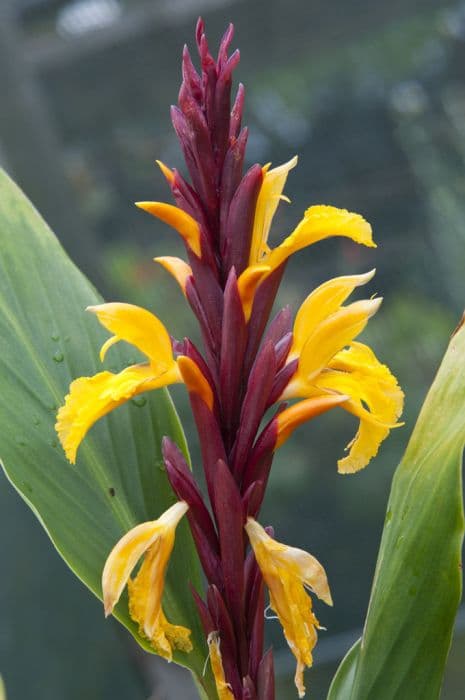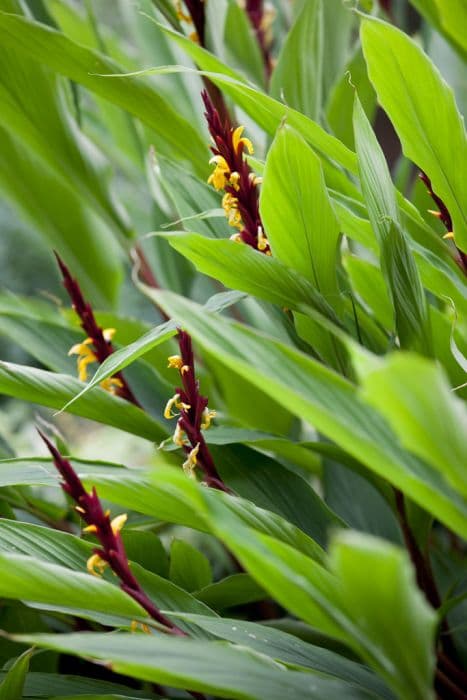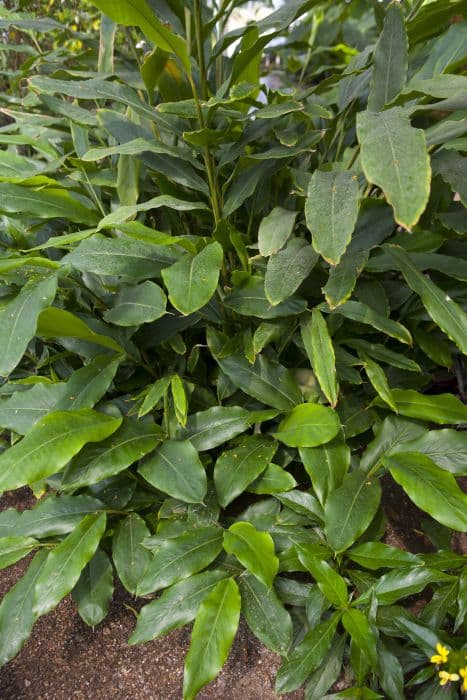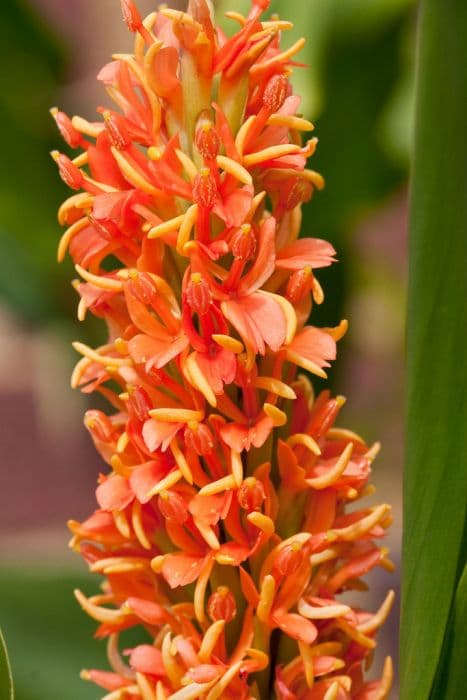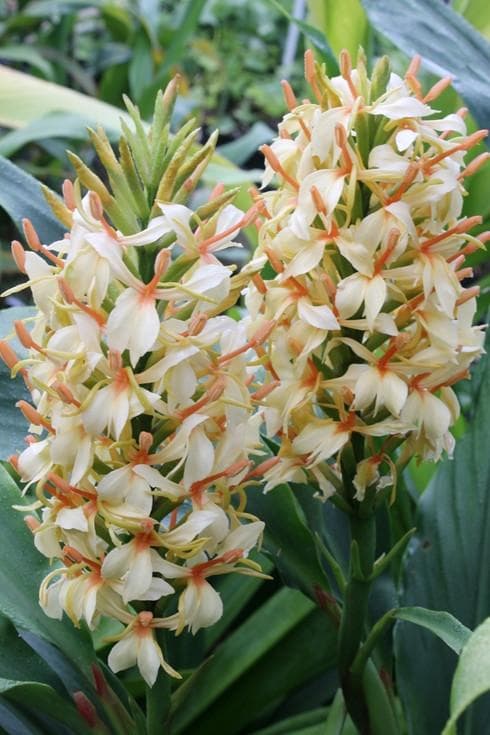Summer Lily Roscoea auriculata 'Floriade'

ABOUT
The Roscoea auriculata 'Floriade', commonly known as the "Summer Gilliflower," is a plant with a distinct and attractive appearance. It bears broad, lance-shaped green leaves that emanate from the base, creating a lush, dense clump. From these leaves rise the striking flower stems that display a beautiful display of blooms. The flowers of the 'Floriade' are trumpet-shaped and come with petals that are a vibrant purple to lilac hue, often with a paler or white throat. The petals have an orchid-like form, which gives them an exotic and delicate look. The flowering part may have both larger and smaller individual blooms, creating a tiered effect. These blooms appear in the warm months and can add a touch of the tropics to the garden. The plant exudes an overall tropical and exquisite feel, although it is hardy and can withstand cooler climates. The contrast between the vibrant flowers and the lush foliage makes the Summer Gilliflower a sought-after specimen for ornamental gardens.
About this plant
 Names
NamesSynonyms
Roscoea, Summer-Flowering Ginger, Ginger Family Jewel
Common names
Roscoea auriculata 'Floriade'.
 Toxicity
ToxicityTo humans
Roscoea does not have a widely recognized common name that is used extensively beyond its scientific name. There is no specific documented evidence that Roscoea auriculata 'Floriade' is toxic to humans. Therefore, there are no specific symptoms of poisoning to describe. However, it's always prudent to be cautious and avoid ingesting any plant not known to be safe.
To pets
Roscoea does not have a widely recognized common name that is used extensively beyond its scientific name. There is no specific documented evidence that Roscoea auriculata 'Floriade' is toxic to pets, either. Hence, no particular symptoms of poisoning can be outlined. Nevertheless, as with any non-food plant, it's advisable to prevent pets from ingesting it as a precautionary measure.
 Characteristics
CharacteristicsLife cycle
Perennials
Foliage type
Deciduous
Color of leaves
Green
Flower color
Purple
Height
1-2 feet (30-60 cm)
Spread
0.5-1 feet (15-30 cm)
Plant type
Herb
Hardiness zones
6
Native area
Himalayas
Benefits
 General Benefits
General Benefits- Attractive Flowers: The Roscoea auriculata 'Floriade', also known as Summer Common Roscoea, produces striking purple flowers that add aesthetic appeal to gardens.
- Drought Tolerance: Once established, Summer Common Roscoea exhibits a degree of drought tolerance, making it suitable for gardens with low water availability.
- Pollinator Friendly: The flowers attract pollinators like bees and butterflies, helping to support local ecosystems.
- Low Maintenance: This plant requires minimal care once established, making it an excellent choice for beginner gardeners or those with limited time.
- Cold Hardy: Summer Common Roscoea is hardy in many climates and can withstand cold temperatures, making it versatile for various garden zones.
- Shade Tolerance: It can thrive in partial shade, offering a beautiful flowering option for shaded areas in the landscape.
- Compact Size: The plant maintains a relatively small size, which is ideal for smaller gardens or growing in containers.
 Medical Properties
Medical PropertiesThis plant is not used for medical purposes.
 Air-purifying Qualities
Air-purifying QualitiesThis plant is not specifically known for air purifying qualities.
 Other Uses
Other Uses- Roscoea auriculata, commonly known as Hardy Ginger, can be used as a natural dye source, providing subtle colors for fabrics and textiles.
- Its rhizomes may serve as a food flavoring, much like its more famous cousin ginger, though it's less common and milder in taste.
- The flowers can be a delicate, edible addition to salads, having a slightly peppery flavor reminiscent of nasturtiums.
- The plant's leaves can be used in the practice of plant printing, where their shapes are used to create patterns on paper or fabric.
- Hardy Ginger can be utilized in educational gardens to teach about biodiversity and the importance of preserving lesser-known plant species.
- The visually striking flowers of Roscoea auriculata can serve as inspiration for botanical artists and illustrators.
- Its robust nature allows it to be used in erosion control within garden landscapes, particularly in shaded areas.
- The plant can be part of a sensory garden due to its distinctive shape and the texture of its leaves, offering a tactile experience.
- Hardy Ginger's unique bloom can be used in photography projects focusing on the geometric patterns found in nature.
- The cultivation of Roscoea auriculata can serve as habitat enrichment for beneficial insects, supporting biodiversity in a garden environment.
Interesting Facts
 Feng Shui
Feng ShuiThe plant Roscoea is not used in Feng Shui practice.
 Zodiac Sign Compitability
Zodiac Sign CompitabilityThe plant Roscoea is not used in astrology practice.
 Plant Symbolism
Plant Symbolism- Rarity: Roscoea auriculata 'Floriade', commonly known as Hardy Ginger, is not a common garden plant, thus it symbolizes uniqueness and rarity in the plant world.
- Exotic Appeal: Being a part of the ginger family, which is associated with exotic regions, Hardy Ginger represents exotic beauty and the allure of the unknown.
- Resilience: Hardy Gingers are known for their resilience and ability to withstand cooler climates compared to other tropical plants, symbolizing strength and the ability to thrive in challenging conditions.
- Healing: Gingers have a longstanding association with medicinal properties, and even though Hardy Ginger is primarily ornamental, it inherits this symbolism of healing and nurturing.
 Water
WaterHardy Ginger Lilies should be watered regularly, about once a week, with a thorough soaking to encourage deep root growth. Ensure that the soil is well-draining to prevent waterlogging. During active growth periods in spring and summer, keep the soil consistently moist, providing about one to two gallons of water per week, depending on the weather conditions. Reduce watering in the fall and allow the soil to dry out slightly between waterings to prepare the plant for dormancy. Over winter, when the plant is dormant, water sparingly, only enough to prevent the soil from completely drying out.
 Light
LightHardy Ginger Lilies prefer a spot that receives partial shade to filtered sunlight. They thrive best when protected from the harsh afternoon sun, which can scorch their leaves, so a location with morning sun and afternoon shade is ideal. They can also adapt to conditions of dappled sunlight under the canopy of deciduous trees, which mimics their natural woodland habitat.
 Temperature
TemperatureHardy Ginger Lilies perform well in temperatures ranging from about 50 to 85 degrees Fahrenheit. They can tolerate brief periods of colder weather down to about 20 degrees Fahrenheit once established but should be protected from prolonged freezing temperatures. Their ideal growing conditions include warm days and cooler nights during the growing season.
 Pruning
PruningPrune Hardy Ginger Lilies in late fall or early winter after the foliage has died back to tidy up the plant and encourage healthy growth for the next season. Pruning is mainly for aesthetic purposes and to remove any dead or damaged leaves. The best time for this task is after the first frost when the plant begins to enter dormancy.
 Cleaning
CleaningNot needed
 Soil
SoilHardy Ginger Lily (Roscoea auriculata 'Floriade') thrives in a rich, well-draining soil mix with high organic matter content. A blend of loam, sand, and peat or compost will provide the desired structure. This perennial prefers a slightly acidic to neutral pH, ranging from 6.0 to 7.0.
 Repotting
RepottingHardy Ginger Lily doesn't require frequent repotting; it can be repotted every 2 to 3 years or when it outgrows its current container. Spring is the best time for repotting to allow the plant a full growing season to establish.
 Humidity & Misting
Humidity & MistingHardy Ginger Lily prefers moderate humidity levels but can tolerate a range of conditions. Aim for around 40-60% relative humidity for optimal growth. Avoid extremely low humidity levels to prevent desiccation.
 Suitable locations
Suitable locationsIndoor
Provide bright, indirect light and keep in a cool room.
Outdoor
Plant in partial shade, protect from strong winds, and mulch.
Hardiness zone
6-9 USDA
 Life cycle
Life cycleThe life cycle of Roscoea auriculata 'Floriade', commonly known as Hardy Ginger, begins with seed germination, typically in late spring or early summer, when temperatures become conducive to growth. The plant emerges as a seedling with narrow, lance-shaped leaves, and develops into a juvenile plant. As it matures, it forms a rhizome, which is a horizontal underground stem that stores energy and allows the plant to survive through winter. In subsequent years, the Hardy Ginger enters a period of vegetative growth each spring, followed by flowering in summer, usually around July or August, showcasing striking purple or violet flowers. After pollination and fertilization, the plant produces capsules containing seeds, which are then dispersed to give rise to new plants. Finally, as temperatures drop in autumn, the above-ground foliage of the Hardy Ginger dies back, while the rhizome remains dormant underground throughout the winter until the cycle restarts with the next warm season.
 Propogation
PropogationPropogation time
Spring-summer
The Roscoea auriculata 'Floriade', commonly referred to as Hardy Ginger, is typically propagated division. The best time to carry out this method is in spring just before the new growth begins. This is usually after the risk of frost has passed, encouraging better establishment of the divisions. To propagate by division, carefully dig up the clump of the plant and separate the rhizomes, ensuring that each division has at least one growth bud. Replant the divisions at a similar depth to how they were previously grown. It's important to water the new plantings adequately to help them establish. After division, the Hardy Ginger's divisions should be spaced about 12 to 15 inches apart (30 to 38 centimeters) to give them enough room to grow. Providing a top dressing of well-rotted organic matter can also help to encourage good growth.





